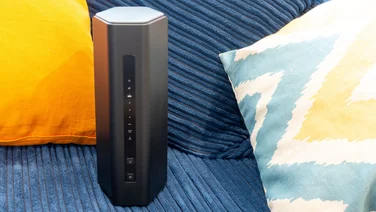To help us provide you with free impartial advice, we may earn a commission if you buy through links on our site. Learn more

With the advent of wireless mesh systems, there’s less imperative to upgrade your main router. After all, a mesh system improves the one part of your router that’s likely to cause the most issues: the wireless connection. The Nighthawk Pro Gaming XR500 is completely different, using the DumaOS operating system to provide features not seen before on a consumer router.
Many of the features are aimed at gamers, but the advanced bandwidth controls and simple interface could well appeal to anyone that wants a stable internet connection.
Netgear Nighthawk Pro Gaming XR500 review: Setup and features
Considering it’s a gaming router, the XR500 isn’t overblown or too large. In fact, it has a rather refined, angled look to it. Setup is pretty straightforward. First, you have to screw in the four antennas; make sure you get the right one attached to the right port, as the two side antennas have a longer connector.
READ NEXT: The best routers you can buy
Next, you use an Ethernet cable to plug the router into your modem, hook up any wired devices you have (there are four Gigabit Ethernet ports), and you’re good to go.
When the router boots up, it takes you through a quick configuration wizard, getting you connected to the internet, and changing the default (but secure) network names and passwords to something you prefer. It makes sense to use the same name and password as your old router’s wireless network, so existing devices will connect to the new router without having to be reconfigured.
One of the router’s most impressive features is the Geo-Filter. When playing online games, if you’re a long way from the physical server, you can suffer from poor performance. Games don’t provide an option to play only on local servers, but the XR500 does.
Once you’ve chosen your location, you can use the slider to set a maximum distance of servers that you’re happy to play on. You can set the distance on a per-game basis, too, widening the net for a particular game, and restricting it to local for other titles. The list of supported games is large, but largely aimed at consoles. The biggest games tend to have localised servers to eliminate these issues.
READ NEXT: Best gaming laptops
More interesting are the quality of service (QoS) controls, which go far and beyond those found in most routers. The standout feature is Anti-Bufferbloat, which is designed to stop one device from hogging your entire internet connection.
Netgear runs a speed test on your line to get the upload and download speeds, and then you can get a slider to choose the maximum amount of bandwidth that any one device can use. This can either be permanent or just when games are being played.
Setting it to permanent means that your maximum download speeds will be capped. To our mind, that’s not a massive problem, as slightly slower speeds are worth it to ensure a smoother experience for all users.
Netgear Nighthawk Pro Gaming XR500 review: Performance
Testing on our internet connection, without Anti-Bufferbloat turned on, we managed download speeds of 72Mbits/sec and upload speeds of 16Mbits/sec. Setting Anti-Bufferbloat to allow a maximum of 70% of these speeds, we got download speeds of 47Mbits/sec and upload speeds of 11Mbits/sec. That leaves plenty of bandwidth for any other devices that need to browse the web, send emails or the like.
Impressively, you can set the maximum bandwidth that each device can use, too. The XR500 also only lets you set the maximum at the maximum level set in Anti-Bufferbloat, preventing any one device from hogging all available bandwidth.
Beyond these two fancy features, the XR500 operates like any other router. There are settings for port forwarding and USB drive sharing, and there’s an option for BT IGMP proxying, which lets the router work with streamed channels from BT set-top boxes. Testing with BT Sport on a BT YouView box, we were impressed that it worked correctly.
Wireless channel selection is set to Auto on the 2.4GHz band, with a maximum throughput set to 800Mbit/sec. The 5GHz band is set to channel 44, with a maximum throughput of 1,733Mbits/sec.

Testing on the 5GHz channel, we saw performance dip over range. Starting at close range, we saw upload speeds of 400Mbits/sec and download speeds of 690Mbits/sec, which is really fast. On the first floor, speeds dropped to an upload speed of 192Mbits/sec and a download speed of 318Mbits/sec. On the second floor, speeds were just 57Mbits/sec upload and 196Mbits/sec download.
It was a similar story on the 2.4GHz band: at close range we saw upload speeds of 124Mbits/sec and download speeds of 117Mbits/sec; on the first floor we saw 66Mbits/sec upload and 71Mbits/sec download speeds; and on the second floor, we saw 55Mbits/sec upload and 55Mbits/sec download speeds.
That doesn’t make the router not worth buying. For gamers, mostly using wired connections, there’s nothing quite like this router, and for a smaller home, the close-range speeds are excellent. For larger homes that want more control over bandwidth usage, the XR500 can still do a great job, but it’s best paired with a mesh system.






